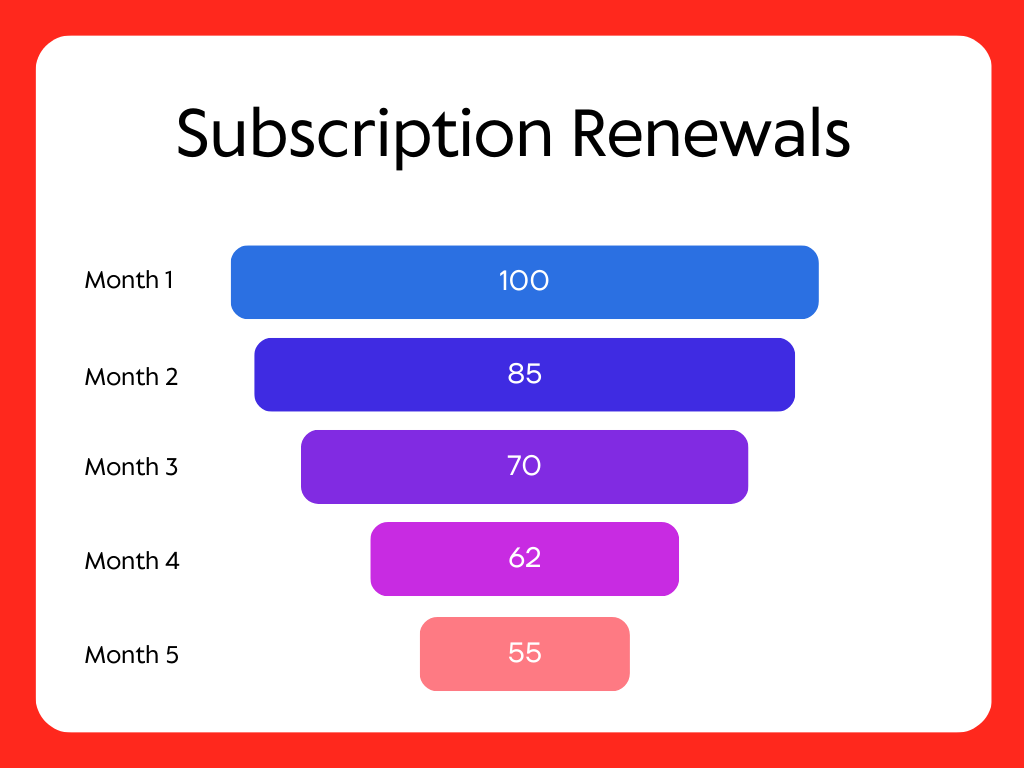Key takeaways:
- Improving conversion tactics at the top of the funnel can have a more significant impact on retention than traditional retention hacks.
- Subscription acquisition strategies like bulk offerings, gifts with purchase, and starter kits can create more value for customers.
- Innovative approaches like “try before you buy” can derisk the purchase decision for potential subscribers.
Most people think of subscriptions as a retention game. You get them to buy, then use email, gifts, discounts, software, and other incentives to keep them on the subscription. So, every brand scrambles to unlock that secret retention ingredient to help people stay longer.
The problem is that while many retention hacks can help, you’ll never see the same impact on retention that you can by improving how people buy. Here is a simple visualization to explain what I mean:

In this example, I start with 100 subscribers and lose them slowly over time. Between months 2 and 3, I lose 15 subscribers. Let’s say I cut churn by 33% that month – I’d keep five more subscribers.
However, if I improve my conversion rate at the top of the funnel by 10%, I’d start with 110 subscribers. Then, any downstream improvements I make to retention will have an even more significant impact.
The Right Conversion Tactics Also Help Retention
The hard truth is that how you offer a subscription influences different types of people, and those people retain differently.
We’ve all seen that post-BFCM dip when subscription churn spikes. Buying around the holidays is great for sales volume, but not everyone is serious about keeping the subscription.
High discounts have a similar effect. People are interested in trying it, but you see high drop-offs from them.
Gifts with purchase, bundles, and bulk options perform better over time. They just influence a different type of subscriber—one who sees more value in what they’re purchasing rather than evaluating based on price.
When the ONLY difference in value between a one-time purchase and a subscription is the discount, you’ll see a large amount of first-month drop-off. Customers take the discount and cancel immediately.
From a CRO perspective, there are many other levers you can use to influence subscriber acquisition and strengthen retention.
Acquisition Tactics That Work
I have seen a lot of subscription offers over the years. Some work better than others, so I’m going to share a few different tactics you can employ and do my best to explain the pros and cons of each.
Selling in bulk
- In this example, the more you buy, the more Obvi gives away.
Selling in bulk gives you more margin to play with, a higher AOV to offset CAC, lower shipping costs (sending three at once versus sending one three times), and the ability to present a price per serving to highlight the difference.
This is my #1 play right now for subscriptions because it works, from brands with a few thousand subs to 100,000.
A few different things are going on with a bulk option. While it feels like you’re adding complexity to the buy box, you can position the middle option positively. Even if you get a small percentage of buyers to take the larger quantities, that increase in AOV is significant and decreases your overall CAC.
The best part? Bulk buyers retain better. A three-month subscription retains better than a monthly after 3 months.
Choose the subscription over the one-time purchase is perceived value
You can do this with discounts, but often, gifts can do much more.
First, consider the cost of discounting another 10% of your product versus the cost of including an item that costs you $2-5 landed. Often, the gift protects more margin, and customers who select gifts typically retain better than those acquired through heavy discounts. They see more value in the product, period.
It can also create a great onboarding experience, as the new subscribers get “all this stuff” when they open the package.
Starter Kits have mixed results
The danger in using them is that you still have to convert someone to a full subscription. Dollar Shave Club famously uses this model (heavily discounted), as does Get Mars Men in this example.
The beauty of the starter kit approach is that you can effectively double down on the gift-with-purchase approach and make a package that is perfect for any first-time user of your product. Starter Kits can have sample sizes instead of full sizes, additional gifts, or multiple flavors (or styles) if you’re introducing someone to the different versions you offer.
The danger here is that if you employ the heavily discounted approach, you’ll be selling to discount seekers again. When you make the starter kit feel elite, premium, or at least a great introduction to your solution, you not only have enough margin to allow for higher acquisition costs, but you’re also speaking to someone who sees real value in your subscription.
One recent trend that I’m excited to watch is the use of try before you buy. Trynow.com is pioneering this, and it essentially allows you to delay when you get billed so you can try the product first.
In this example, Jolie gives buyers 10 days to try the product at home before they get charged.
This de-risks a large part of the purchase decision for subscribers, and the initial results are strong. Using this method can give your brand a 20% increase in subscription attachment rates and a 30% reduction in CAC.
Instead of using heavier discounts here, you can essentially put your money where your mouth is and let consumers test the product first!
Focus on your offer
Your best bet to improve retention this year is to focus on your offer. This means looking at the top of your subscriber funnel to improve not only the quantity but also the quality of subscribers.
As a growing brand, you’ll employ a variety of offers for different people and at different times of the year. Discounts work to acquire subscribers, but putting more work into some of the methods mentioned above can not only improve first-order profitability but also retention.
When we change how people come in the door, we can influence why they stay.
Matt Holman is the founder of Subscription Prescription, a consultancy and media company focused on improving the state of subscriptions in D2C. Check out his newsletter, podcast, or reach out for a chat at https://thesubscriptiondoc.com

